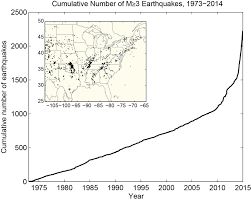Report: Earthquakes tied to oil and gas wastewater injection rising in US

Earthquakes linked to injection of wastewater from oil and natural-gas development have increased sharply since 2009 in the central and eastern U.S., including in Colorado, according to a new study by the U.S. Geological Survey.
Researchers listed Greeley as one of the 17 zones where oil and gas wastewater injection may have caused induced seismicity, according to the report released Thursday. Scientists also looked at earthquake activity in Oklahoma, New Mexico, Arkansas, Kansas, Texas, Ohio and Alabama.
Scientists developed hazard models by analyzing earthquakes in these zones and considering their rates, locations, maximum magnitude and ground motions.
SPONSORED CONTENT
Business Cares: May 2024
As Mental Health Awareness Month unfolds in Colorado, it serves as a reminder of the collective responsibility to prioritize mental well-being.
“The proportion of small-to-large earthquakes is greater in regions of induced seismicity than the global average,” reads the study.
Weld County has seen growing oil and natural-gas production since 2009 driven by advancements in hydraulic fracturing, or fracking, and horizontal drilling. The region also has seen earthquake activity in areas near injection wells monitored by University of Colorado-Boulder scientists since last year.
Nearby states also have seen increased earthquake activity. In 2011, an earthquake in Oklahoma tied to wastewater injection registered a 5.6 magnitude on the Richter scale, the largest human-induced earthquake to date, according to the study.
Fracking generates enormous amounts of wastewater that oil companies typically inject thousands of feet underground. Fracking involves pumping millions of gallons of water mixed with sand and chemicals into a drilled hole to extract oil and gas from dense shale formations. In Colorado, injection wells are designated specifically for wastewater and regulated by state authorities.
Last summer, the Colorado Oil and Gas Conservation Commission briefly suspended activity at an injection well operated by NGL Water Solutions DJ LLC after large quakes struck near Greeley and a public outcry erupted. Injection activity was then allowed to resume in late July and the state launched an investigation into whether NGL had violated the terms of its disposal permit.
The state oil commission linked the company’s wastewater well to the earthquakes, and low-level tremors occurred during the months after the company resumed injection activity.
The state oil commission ultimately determined that NGL neither violated its permit from the state nor broke the state agency’s rules.
The report by the Geological Survey attempted to calculate how often earthquakes might occur in the next year and how hard the ground will shake as a result. The researchers concluded that numerous variables pose challenges to earthquake forecasting.
“It is difficult to assess future earthquake rates since the earthquakes vary rapidly in space and time, and may also depend on economic decisions and regulatory action,” reads the study.
Earthquakes linked to injection of wastewater from oil and natural-gas development have increased sharply since 2009 in the central and eastern U.S., including in Colorado, according to a new study by the U.S. Geological Survey.
Researchers listed Greeley as one of the 17 zones where oil and gas wastewater injection may have caused induced seismicity, according to the report released Thursday. Scientists also looked at earthquake activity in Oklahoma, New Mexico, Arkansas, Kansas, Texas, Ohio and Alabama.
Scientists developed hazard models by analyzing earthquakes in these zones and considering their rates, locations, maximum magnitude and ground motions.
“The proportion of small-to-large earthquakes is…
THIS ARTICLE IS FOR SUBSCRIBERS ONLY
Continue reading for less than $3 per week!
Get a month of award-winning local business news, trends and insights
Access award-winning content today!

